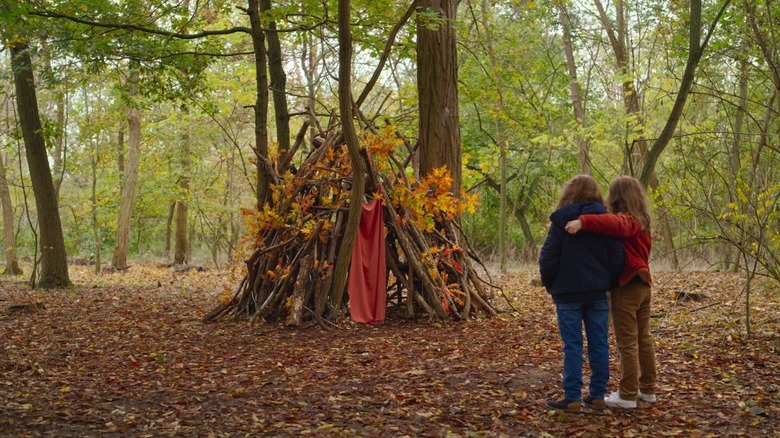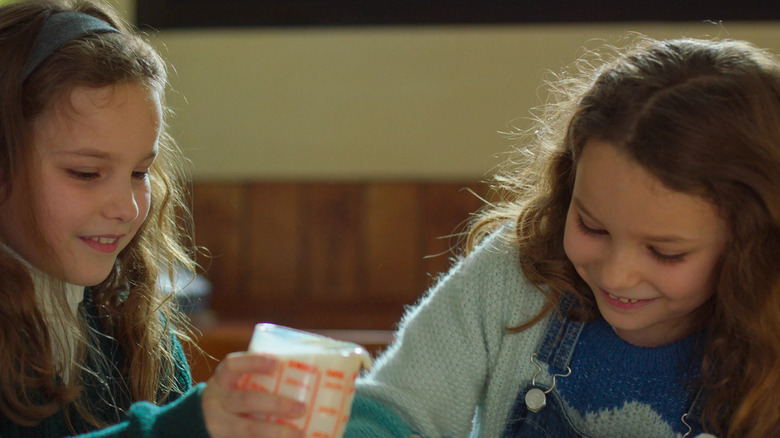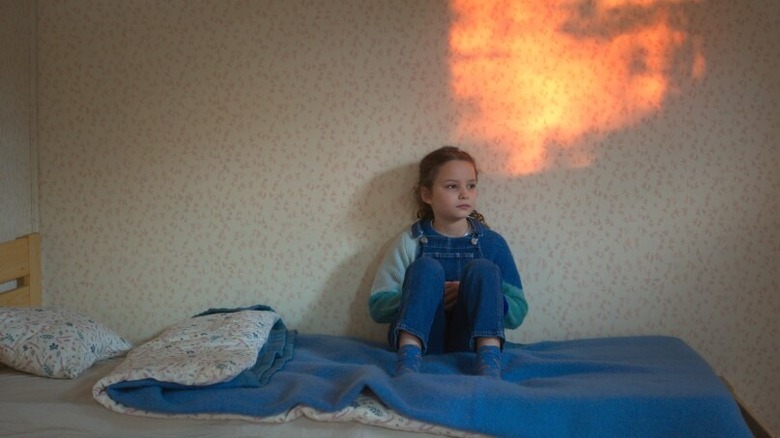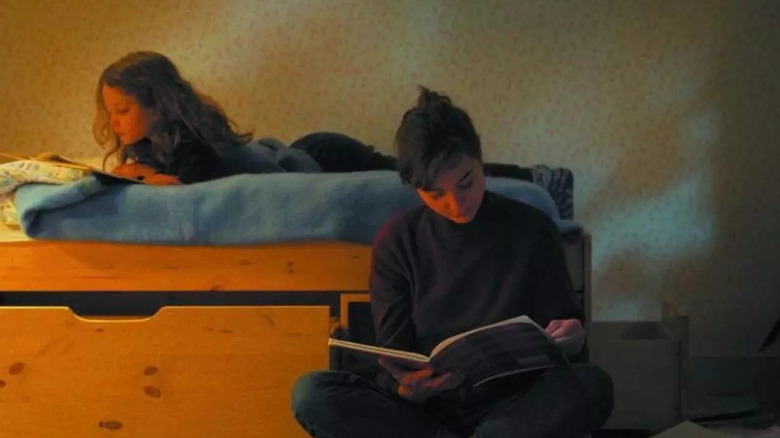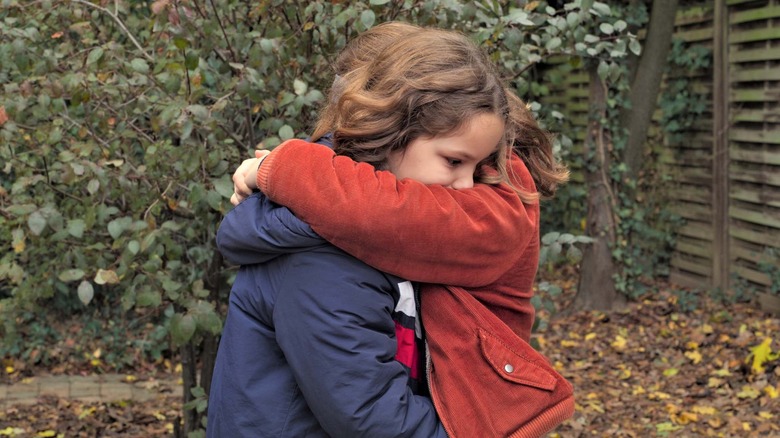Petite Maman Director Céline Sciamma On Filming In Her Hometown And Telling Smaller Stories [Interview]
"Petite Maman" is a small film, in more ways than one. It's got a slight runtime that barely clocks in at over an hour, and it's got an even slighter story — at least on the surface.
Directed by Céline Sciamma, "Petite Maman" follows an 8-year-old girl named Nelly (Josephine Sanz) who, while accompanying her mom to clean out her recently-passed grandmother's house, wanders through a nearby wood that takes her back in time. There, she meets her mother at her age (Josephine's sister, Gabrielle Sanz), and the two become instant playmates. It's more of a fable than a sci-fi film, a sweet and intimate examination of grief and loss that plays like a slice-of-life story.
It might seem strange that Céline Sciamma's follow-up to "Portrait of a Lady on Fire" is such a modest film, but to Sciamma, it was the natural project to embark on in the early days of the pandemic.
"I wasn't in a rush to make another film," Sciamma said in an interview with /Film ahead of the U.S. theatrical release of "Petite Maman." "I [had] just come back from the U.S. in March 2020, but had this film in the back of my mind for so long that I started writing it."
Sciamma would stop writing the script when France went into lockdown early on in the coronavirus pandemic. But she picked it up again because, she believed, pandemic-era moviegoers would need a movie like "Petite Maman."
"I kept thinking about the fact that, when cinemas would reopen, there would be images from before, very candid ones," Sciamma said. "And they would do us good but they would also hurt, and that we needed images aware that would've been made through this."
Those images: two girls standing in front of a ramshackle hut made of red and burnt orange leaves. A mother curled up in her dusty childhood room. An empty house getting slowly emptier. They're simple images, but resonant and universal. And it's on these images that Sciamma built the backbone of her film, "a mythological story," she said, but a deeply personal and intimate one.
"I think one might say it's [a] modest film, small film," Sciamma said. "But for me, it has the ambition to have a very, very strong, emotional impact. It's a very immodest film for me. I consider the film like a little spell."
I spoke to Sciamma about "Petite Maman," shooting early in the pandemic in her hometown, and the line of dialogue that would make for the connective tissue between her latest film and "Portrait of a Lady on Fire."
This interview has been lightly edited for clarity.
"This film wasn't a personal lockdown. It was a way to stay connected"
You started writing the script for this in lockdown in March 2020, and rushed it to production to begin shooting in Fall 2020. And even now, two years later, "Petite Maman" feels like the quintessential pandemic movie, a way to process the trauma and despair that people have experienced through a sweet fable. Was the writing and making of this film a way of processing everything for you, as well?
Well, it was a way to process ... because I wasn't in a rush to make another film. I [had] just come back from the U.S. in March 2020, but had this film in the back of my mind for so long that I started writing it. Then when the lockdown happened, I stopped writing it. I didn't write it during the lockdown, but it's just ... it felt so connected to what we were going through and what we needed. And I didn't feel I had to rush, because this would end. I felt like we were going to need these images for long.
And I kept thinking about the fact that, when cinemas would reopen, there would be images from before, very candid ones. And they would do us good but they would also hurt, and that we needed images aware that would've been made through this.
For myself, well, I was able to work. We shot during the second lockdown in France and I was able to work. We were crossing an empty city to go to a studio where ... a little girl would take off her mask and we would film her eating cereal ... This film wasn't a personal lockdown. It was a way to stay connected. This is a two-year job. That's also why we went to Berlin. That's also why we went to festivals, even though they were virtual. We wanted to participate. And it's been a way to process this whole thing, for sure. And mostly also because, not much while doing it, but then receiving a lot of testimonies of grief, of loss. Because when you come with such a story, then you receive a lot of story.
It's also been a way to stay strongly connected, especially because working with kids — we see how they've been treated during this pandemic. Being connected to that, to their stories, and to a collective loss felt important.
You shot partially in your hometown, and I read that you recreated spaces that were similar to your own childhood home in the studio. So shooting that, and shooting in spaces that were so personal and intimate, what was that like, especially early on in the pandemic?
Well, it's true that when I realized that I was going to eat my lunch in my kindergarten school, it felt — I didn't at all do it for that. I picked that place because I know it very well, and as ... the film is kind of magic, you had to design a map of magical paths from the past to the future.
If you have to look at a place from a very fictional way, it helped me to design it in a place I know very well, that is not charismatic at all. It's a very small wood.
But that's the thing about [the] playground that you knew as kids. You believe they can turn into everything. As you know, my room became a castle, my back became a horse, and this forest can become cinema.
But it's true that when I was building that treehouse with all these adults and that Claire Mathon, the DP, was putting leaves everywhere, I felt like ... if I could take a time-traveling machine and go and see the kid that I was, I'd be like, "See? Your life is exactly the same, except now you're doing it professionally."
"It's been told. It will be told. It's not been transmitted"
So because of the time-travel elements, this movie could be described as science fiction, but it feels more like a fable or fairytale. What is the appeal of bringing this sort of fairy tale element into this movie and some of your recent movies, too — I remember it in a "Portrait of a Lady on Fire," as well as "My Life as a Zucchini" — and to use that to dig into deeper or more or darker themes?
There's a high concept in the film. And I think the decision of the film is not too harvested ... but to fully respect the opportunity. And it's a way to be intimate.
It's like when you ask people, where would they go if they had a time-traveling machine, usually they choose to go tourism in the past or activism in the past. But no one's saying like, "Oh, I'm going to go and see my grandmother and hang out with her when she was 12," for instance. Because why would you need such a machine to do something so personal?
Well, I think the film is exactly doing that. And by that, I hope it's just ... putting in this new very playful idea that you can harvest yourself with your own story. Think about yourself and your parent as a kid, I think could be a form of fictional healing process.
I know you said that you had this idea in your head for a long time. I heard that you actually came up with it while writing "Portrait of a Lady on Fire." What sparked the idea specifically?
I will never know. [The only thing I had was] an image of two little girls playing in the woods doing a treehouse, just this image, actually. And I was like, "Oh. One is the mother and one is the daughter." And I will never know. And that's also why I was like, "This is a mythological story." It's been told. It will be told. It's not been transmitted. "Turning Red" is actually really, really close.
Yeah. There's a scene in "Turning Red" that looks like it came right out of "Petite Maman."
It's crazy. The film is beautiful, brilliant. It's one of the best. But I was also moved by the fact that this is mythology. This is our mythology. And this is the language of cinema we're doing when we are doing cinema, in a way. And it was part of the joy of being so moved by the film. So the spark was this idea, and then the joy was to tell it my way.
"I consider the film like a little spell"
A lot of international audiences came to you through "Portrait of a Lady on Fire," but "Petite Maman" is kind of a return to your roots in many ways. It's a smaller story. It's centered around children. Why do you feel drawn to these types of stories specifically?
Well, I think because they hit hard. I think one might say it's [a] modest film, small film. But for me, it has the ambition to have a very, very strong, emotional impact. It's a very immodest film for me. I consider the film like a little spell.
Sorry, what was your question? I got lost.
Why are you drawn to these types of smaller stories?
I guess because you can be really, really free. Really, really free to do it exactly the way you feel or you want. That's an asset of that kind of scale. And also I really wanted to film to be ... that kids could watch the film. Each time I write for kids, I want kids to be able to watch the film.
And that's also why it's short, so that a kid and an adult can both feel equally respected sitting through this, enjoying it. For me, it was the right scale of the great adventure.
What was it like taking that departure from your style to do a lush, erotic film like "Portrait of Lady on Fire," and then coming back to a little, intimate, personal story like "Petite Maman"?
It didn't feel that different, I must say. No. Shooting in studio is for instance, is a huge challenge. I never had that many lights. I never had that many workers, in a way.
So the scale of the film is really, really going through production and less ... of course, it was less heavy than "Portrait of a Lady on Fire," because it was shorter. But it's the same kind of job. You have to pick everything in the frame in the end. And to me, the fact that the films are both structured in a way with some sort of form of healing and deliverance from a love you lost. I think they're working hand-in-hand in the politics of feelings, also.
"It's the moment when the heart breaks and then a relief"
Let's talk about your two lead actresses, Josephine and Gabrielle Sanz. It's so difficult to find good child actors, but you have a real talent for finding ones that can really carry entire movies and the emotional weight of the movies, like with "Petite Maman," and also with your previous films, like "Tomboy." When looking for a child actor, what do you specifically look for in your star?
Well, I just saw them. So, I don't know if it means that I'm looking for just the opportunity, or if I'm looking for something so strongly that I just need to see it once. I don't know.
For me, the casting was built around an idea that I wanted sisters to play the parts. And once you get an idea like that, then it's all about how the world is going to respond. My luck is that kids that come to my casting, they've seen my film because they've seen "Tomboy." They've seen "My Life as a Zucchini." So they're coming for that kind of cinema.
They know about the language of cinema. They're going to speak with you, in a way. So, it's quite mutual. And I don't even try to make them play, because kids know how to play. Then it's all about the set. I don't even rehearse, because then it's all about 14 people and a huge camera.
I don't find it a very different job between collaborating with kids or adults. The only thing that they have to learn [is] the job. There's like 24 to 48 hours where they learn the protocol of cinema, but it goes really fast and ... then it's all about building the language of the film together. We always talk about cinema. And I think that may be why [there's] this kind of weird quality to the performances of kids in my films. It's just that it's never about their emotions. So I'm not asking them to be sad or to feel [a certain way]. We always talk about cinema.
So it's like, "Oh, this is like a horror film. This is like a spy film. This is a love scene." And kids, they know really well about cinema. So they know how to adapt that language to their bodies and their ideas and your film.
The only thing is that you have to be really, really fast. You have to know very well what you want. This is why the film is also very compact. You have to have strong ideas each time.
So I wanted to ask you about this one line, which for me was one of the defining moments of the film, and honestly, one of the most moving moments in film for the year, for me. It's when Marion tells Nelly, "You didn't invent my sadness." And I love this because it felt like the emotional linchpin of the movie where a young Marion was offering Nelly the understanding of her mother that she needs, and the forgiveness that she didn't know that she craved. Can you speak about this line and its context in the film? How it came to you? What it means to you specifically?
Well, that line is exactly the line that... when you were asking me about the link between "Portrait of a Lady on Fire" and "Petite Maman," that line is the key of the film. Like, "Don't regret," remember, was the key line in "Portrait of a Lady on Fire." For me, it's like hypnosis. It's a sentence that wakes you up or puts you deeper in the film.
That's when I was saying, "Oh, I was handed confidence." It's that kind of confidence. When a sentence resonates and frees you, gives you some form of freedom or peace.
And I really, really wish I would've heard that as a kid. So you should put it in a film. I mean, every kid needs to hear this. Every kid, everyone. And I think it's the moment when the heart breaks and then a relief.
"Petite Maman" opens in U.S. theaters on April 22, 2022.
